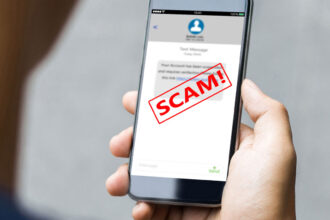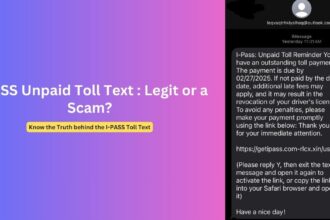In recent months, Michigan residents have been increasingly targeted by sophisticated text message scams claiming to be from the Michigan Department of Transportation (MDOT). These fraudulent messages demand payment for supposed “unpaid tolls” and threaten legal action if recipients don’t comply immediately. The scam has become so widespread that both MDOT Director Bradley Wieferich and Michigan Attorney General Dana Nessel have issued official warnings urging residents to remain vigilant.
What makes these scams particularly notable? Michigan doesn’t have toll roads.
Overview of the Michigan Department of Transportation (MDOT) Final Reminder Toll Scam
The toll road scam targeting Michigan residents is part of a larger nationwide phishing campaign that has generated over 60,000 complaints to the FBI’s Internet Crime Complaint Center in the past year alone. The scam has become increasingly sophisticated, with recent versions including fake government websites that mimic MDOT’s official site but with slightly different URLs.
“While this toll scam isn’t new, it is becoming more prevalent, particularly in West Michigan,” warned Michigan Attorney General Dana Nessel in an April 16 statement. “Before entering your credit card information in response to any kind of text message, take a moment to look closely.”
The scam isn’t limited to Michigan – similar fraudulent messages are being sent across the country, impersonating legitimate toll collection systems like Florida’s SunPass, California’s FasTrak, and the multi-state E-ZPass system. What makes the Michigan version particularly obvious is the simple fact that Michigan doesn’t operate any toll roads, though the state does collect tolls at specific bridges and tunnels.
How the MDOT Toll Text Scam Works
The scam follows a calculated pattern designed to create urgency and fear:
- Initial Contact: Victims receive an unsolicited text message claiming to be from MDOT or a related toll authority.
- False Urgency: The message creates immediate stress by using phrases like “final reminder” and threatening penalties, legal action, license suspension, or vehicle registration problems.
- Deceptive Links: The text includes a link that appears official at first glance but actually directs to a fraudulent website designed to steal personal and financial information.
- Confirmation Request: Many versions ask recipients to reply “Y” or perform specific actions to “activate” the link, which serves to confirm that the phone number belongs to an active user.
- Data Theft: If a victim clicks the link and enters their information, scammers capture sensitive data including credit card details and security codes.
According to cybersecurity experts, these scams aren’t just about stealing one-time payments. Recent investigations by security researcher Brian Krebs revealed that information collected through these phishing schemes is being used to add victims’ credit cards to mobile wallets on stolen phones in China, enabling more extensive fraud.
Text Message Patterns and Variations
The fraudulent toll texts follow recognizable patterns but often vary in specific wording. A typical message might read:
Michigan Department of Transportation Final Reminder: You have an outstanding toll. Your toll account balance is outstanding. If you fail to pay by [specific date], you will be penalized or subject to legal action.
Now Payment:
[Fraudulent Link]
These messages frequently contain several telltale characteristics:
- Generic references to “tolls” without specific details
- Urgent deadlines (usually within a few days)
- Threats of additional penalties
- Instructions to reply with “Y” or to click on shortened links
- Awkward phrasing like “Now Payment” or odd punctuation
- Instructions to “exit SMS and open again” to activate links
The scammers use various domains for their fraudulent websites, often employing tricks to make URLs appear legitimate. Common patterns identified by cybersecurity companies include:
- Domains ending in .vip, .top, .cc, .xin, or other non-standard extensions
- URLs that begin with legitimate-looking text (michigan.gov-) followed by random letters
- Shortened bit.ly links that mask the actual destination
Red Flags: How to Spot an Michigan Toll Scam
Several immediate red flags can help Michigan residents identify these scams:
1. Michigan Has No Toll Roads
The most obvious indicator for Michigan residents is that the state doesn’t operate toll roads. While Michigan does have toll bridges (Mackinac Bridge, Blue Water Bridge, International Bridge) and some private toll facilities, these tolls are collected on-site or through official billing by mail, never via text message.
2. Communication Method
Legitimate government agencies like MDOT don’t send text messages demanding payment. As Transportation Director Bradley Wieferich stated, “You will never receive a bill from MDOT via text message.” Authentic toll notices are sent through official mail with proper documentation.
3. Suspicious Phone Numbers
Many of these scam texts originate from international phone numbers or unusual area codes. In numerous reported cases, the scam texts came from Philippines country codes (+63) or used unusually long numbers with 10+ digits.
4. Poor Grammar and Urgency
Legitimate government communications are professionally written and don’t create artificial urgency. The scam messages often contain grammatical errors, unusual punctuation, and threatening language designed to pressure recipients into immediate action.
5. Website URL Discrepancies
The scam websites might look convincing at first glance, but careful inspection reveals inconsistencies. Legitimate government websites use .gov domains without additional extensions like .cc or .vip.
Protecting Yourself: What to Do if You Receive a Suspicious MDOT Text
If you receive a text message claiming to be from MDOT about unpaid tolls, follow these guidelines to protect yourself:
Don’t Engage with the Message
- Never click on links in suspicious text messages
- Don’t reply to the message, even to say “STOP” or “NO”
- Don’t call numbers provided in the message
Responding in any way confirms your number is active, potentially leading to more scam attempts.
Report the Scam
- Forward suspicious texts to SPAM (7726)
- Report to the Federal Trade Commission
- File a complaint with the FBI’s Internet Crime Complaint Center at www.ic3.gov
- If concerned about legitimate tolls, contact MDOT directly at 517-241-2400 or [email protected]
Check Your Accounts
If you’ve already clicked on links or provided information:
- Monitor your financial accounts for unauthorized charges
- Contact your bank or credit card company immediately
- Consider placing a fraud alert on your credit report
Use Built-in Security Features
- Enable spam-blocking tools on your mobile device
- Consider using call-blocking apps designed to filter scam texts and calls
- Keep your phone’s operating system updated with the latest security patches
Frequently Asked Questions
1. Is the Michigan Department of Transportation (MDOT) Final Reminder Text Legitimate?
No. MDOT does not send text messages about toll payments. Any text claiming to be from MDOT regarding unpaid tolls is fraudulent. Legitimate toll notices from the few toll facilities in Michigan are sent via official mail.
2. Does Michigan Have Toll Roads?
No, Michigan does not have toll roads. The state does operate toll bridges and tunnels, including the Mackinac Bridge, Blue Water Bridge in Port Huron, and the International Bridge in Sault Ste. Marie. However, these tolls are collected on-site or through official billing by mail.
3. Why Am I Getting Toll Texts When My State Doesn’t Have Toll Roads?
Scammers send these messages randomly to phone numbers across the country, regardless of location. They don’t target only residents of states with toll systems. Many recipients in states without toll roads or even people who don’t drive have reported receiving these fraudulent messages.
4. What Should I Do If I’ve Already Responded or Paid?
If you’ve already provided personal or financial information in response to one of these scams:
- Contact your bank or credit card company immediately
- Cancel any compromised cards
- Monitor your accounts closely for fraudulent activity
- Report the incident to local law enforcement and the FBI’s Internet Crime Complaint Center
5. How Do Government Agencies Actually Collect Toll Payments?
Legitimate toll authorities:
- Send official notices by mail with specific details about the toll incurred
- Include photos of license plates and details about where and when the toll was incurred
- Provide official government websites or mail-in payment options
- Never demand payment via prepaid gift cards, wire transfers, cryptocurrency, or payment apps
- Don’t threaten immediate legal action without multiple formal notices
Conclusion: Staying Vigilant Against Evolving Scams
The Michigan Department of Transportation (MDOT) toll scam represents a concerning trend in how scammers are adapting their techniques to appear more legitimate. While the fact that Michigan doesn’t have toll roads makes this particular scam easier to identify for informed residents, the sophistication of these attempts continues to increase.
Attorney General Nessel emphasizes that government agencies will never request personal information or demand money through email, text, or phone calls. Legitimate government communications come through official mail and provide multiple payment options.
As these scams evolve, the best protection remains awareness and skepticism. Before responding to any unexpected message about tolls or other government fees, verify through official channels by contacting the agency directly using contact information from their official website.
By staying informed and cautious, Michigan residents can protect themselves from becoming victims of these increasingly common toll scams. Remember that taking a moment to verify before responding can save significant financial and personal hardship in the long run.






































